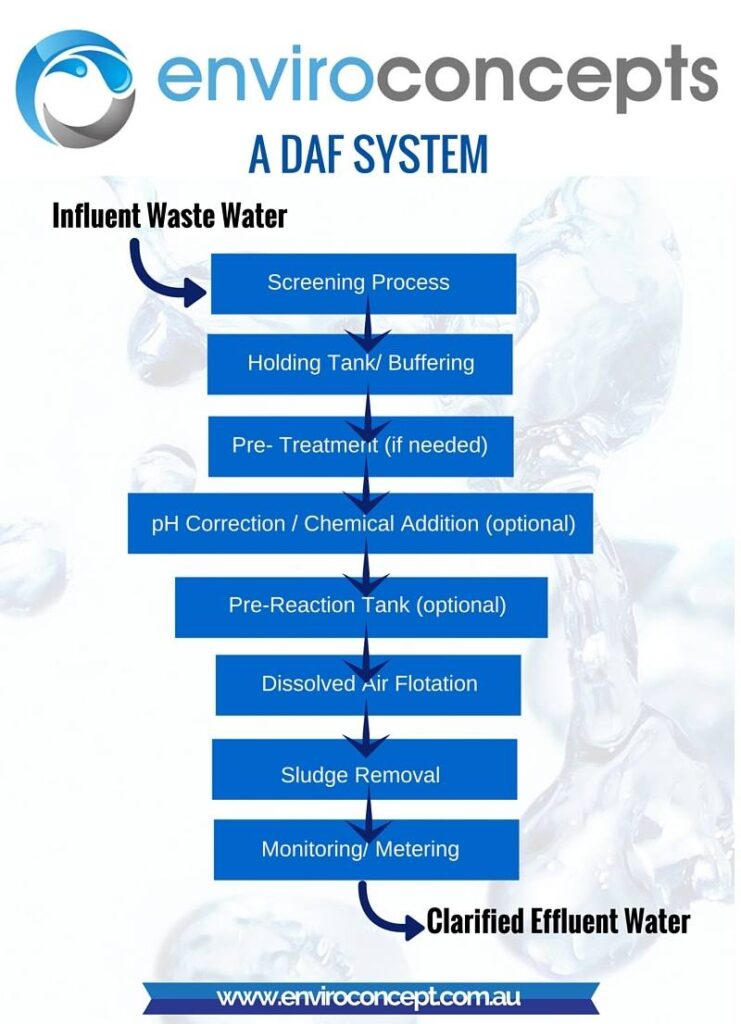What Does Your Complete DAF System Look Like?
Dissolved Air Flotation (DAF) units are used for treating industrial trade waste water high in solids, grease and insoluble BOD. Whether it is food manufacturing or other industrial processes that produce high oil and grease in their wastewater, you must maintain adequate trade waste discharge quality or treat the water for recycle and reuse.
Sites that need DAF
There are certain sites that require more than a grease arrestor or settling pit. The higher loads, flows and higher temperatures (for example, wastewater found in commercial kitchens) can result in poor separation and therefore something heavy-duty is needed. For sites where chokes impact the downstream sewer or where there is a danger of discharge water quality exceeding acceptance limits, a Dissolved Air Flotation (DAF) system is the best practice trade waste treatment option.
The DAF System Simplified
Each industry generates different types of wastewater, with different characteristics. Each type has unique treatment problems. Therefore, the DAF is a part of a larger system used for oil and grease removal, water and wastewater clarification. A Typical DAF system could be designed as follows:
Step 1: Screening Process
Screening is used to remove gross solids from trade waste influent. This prevents solids from blocking the wastewater feed pumps and the DAF recycle pumps. It also minimizes sludge formation over the aeration bars in the DAF, which could prevent DAF’s micro bubble formation.
A range of screen filters are available in the market. You can take a look at our Static Screen Filters and Continuous Media System as screening options.
Step 2: Holding Tank or the Buffering Process
The next part of the process is to send the screened water into a holding or solid settling tank. Keeping the water in the tank for a certain period of time before treatment moderates the water quality. Key parameters moderated are temperature, pH and solids. In fact, buffering moderates solids concentration. It is a better alternative than adjusting the ongoing DAF settings for effectively coping with short term, high contaminant concentration events.
More information on solids settling tanks can be found on our Tanks webpage.
Step 3: Pre-Treatment Process
Aside from screening, further pre-treatment may be required for select industries. An oil water separator can be used to remove free oil and hydro carbons or a clarifier can minimise solids loading prior to the DAF unit. This process is optional.
You can take a look at our Oil Water Separator and Lamella Clarifier pages for more detail.
Step 4: pH Correction, Coagulation and Flocculation
pH correction systems may be required for trade waste discharge compliance, or for balancing prior to coagulation. pH can also be important in reducing foaming caused by detergents in vehicle wash applications.
Coagulation and Flocculation dosing systems are used to mazimise DAF’s efficiency. We develop a specialized recipe around your waste stream which allows for the small particles to flocculate and bind together so the DAF can float them more quickly and easily. In some industries this is essential to proper operation.
Take a look at Enviro Concepts pH Adjustment page and Chemicals page.
Step 5: Pre-Reaction Tank
Pre-reaction tank is not always needed but generally required for certain industrial waste. A pre-reaction tank provides adequate retention time to ensure optimum contact with chemicals before aeration. This is an optional process which provides additional buffering before DAF treatment.
Step 6: The DAF Unit
The Dissolved Air Flotation (DAF) systems are engineered to efficiently remove suspended solids, fats and oils, BOD, COD, and heavy metals from wastewater. In our article, The DAF advantage, we talk about how the DAF uses dissolved air and water to create millions of micro bubbles that attach to particles and solids in the wastewater and float to the surface as sludge. A motorized scraper scrapes the sludge into a waste tank for disposal.
You can download our DAF Specification sheet for a detailed look at the product. Enviro Concepts’ range also includes the SDAF (Sedimentation Dissolved Air Flotation) and the specs sheet can be found here.
Step 7: Sludge Disposal
As discussed in the previous segment, the screening, pre-treatment and the DAF produce a significant quantity of sludge that is needed to be discharged properly, off-site. For our clients, we offer a sludge pumping and collection tank to help them in the discharge process.
Step 8: Monitoring
Effluent flow meters monitor the discharge quality of the water. This is the final stage of the process where pH, TDS (Total Dissolved Solids) should be monitored.
The DAF system requires periodic maintenance. You can visit our Services and Maintenance page for more information.
To enquire about DAF for your facility, contact us here.


